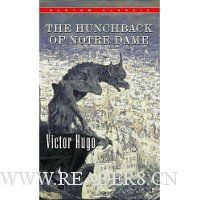
基本信息出版社:Bantam Classics
页码:384 页
出版日期:1981年02月
ISBN:0553213709
条形码:9780553213706
版本:1981-02-01
装帧:简装
开本:32开 Pages Per Sheet
丛书名:Bantam Classics
外文书名:巴黎圣母院
内容简介 Book Description
Before the huge crowd that packed the cathedral square, La Esmeralda stood between two executioners. Suddenly Quasimodo, the hunchback of Notre Dame, rushed at the executioners and felled them with his enormous fists. He snatched the gypsy girl in one arm and ran with her into the church. A moment later he appeared at the top of the bell tower. Holding the girl above his head, he showed her triumphantly to all of Paris while his thunderous voice roared savagely to the sky: “ Sanctuary Sanctuary Sanctuary ”
Set amid the riot, intrigue, and pageantry of medieval Paris, Victor Hugo’ s masterful tale of heroism and adventure has been a perennial favorite since its first publication in 1831 and remains one of the most thrilling stories of all time.
From School Library Journal
Grade 6-9. These visually appealing abridgments of classic titles make fairly difficult and complex novels accessible to a junior high audience. Virtually all kids are aware of Disney's not-so-ugly Quasimodo as the hunchbacked bell ringer of the Notre Dame Cathedral in 15th-century hang-'em-high Paris, and many will have seen some film version of Dracula. Massively trimmed, these retellings have brief, readable chapters; the violence is toned down and the eroticism erased. Competent illustrators bring visual unity to the presentations. Beginning with table-of-contents pages that feature portraits of the casts of characters, the books then devote a few pages to setting the place and mood of the tales. Two-page spreads of text and drawings are framed by related facts and illustrated with details from paintings, photographs, and even movie stills, all of which provide fascinating geographical, historical, and archaeological tidbits. These heavily illustrated books are guaranteed to give young people a leg up on high school and college English classes with their vivid re-creations of cruel, horrific, and romantic European worlds.
John Sigwald, Unger Memorial Library, Plainview, TX
From Library Journal
Hugo's standard is being reprinted to tie in with the Disney animated feature. Though the average kid is not likely to wade through this epic, Hyperion's illustrated edition is actually quite nice if you're looking for a quality hardcover at a good price.
From Kirkus Reviews
The Hunchback of Notre Dame (40 pp.; $15.95; Sept. 1997; 0-531- 30055-2): A storybook retelling of Hugo's classic of the lonely bellringer and his hopeless love for the beautiful gypsy girl, Esmerelda, whom he rescues from hanging and the evil archdeacon Dom Frollo and reunites with her mother. While remaining relatively faithful to the original, this version from Wynne- Jones (The Maestro, 1996, etc.) is always competent, but never compelling. Slavin creates lovely illustrations, but his pale washes leave even the most festive scenes sedate. The volume lacks power or emotion; adults seeking an alternative--any alternative--to the Disney film may find that this one hardly competes for the hearts and minds of the target audience. (Fiction. 5-8)
From AudioFile
Set in fifteenth-century Paris, Hugo's powerful novel evokes medieval life as it tells of the doomed love of Quasimodo, the grotesque bell-ringer at the Cathedral of Notre Dame, for Esmeralda, the beautiful gypsy. Bill Homewood's vibrant performance captures the passion of Hugo's characters in his spellbinding narration. Whether he's thundering Frollo's lust or bellowing Quasimodo's despair, Homewood's strong voice reveals the emotions of the characters with skill and confidence. Fine liner notes include information about Hugo and a list of the classical music skillfully selected for the narrative transitions. P.B.J.
Book Dimension :
length: (cm)17.4 width:(cm)10.6
作者简介 Victor-Marie Hugo was born in 1802 at Besanon, where his father, an officer under Napoleon, was stationed. In his first decade the family moved from post to post: Corsica, Naples, Madrid. After his parents separated in 1812, Hugo lived in Paris with his mother and brothers. At twenty he married Adele Foucher and published his first poetry collection. Hugo was elected to the Academie Francaise in 1841. The accidental death two years later of his eldest daughter and her husband devastated him and marked the end of his first literary period. By then politics had become central to his life. Though he was a Royalist in his youth, his views became increasingly liberal after the July revolution of 1830: Freedom in art, freedom in society, there is the double goal. He initially supported the political ascent of Louis Napoleon, but turned savagely against him after being denied a role in government following the coup de'tat of 1851. Hugo went into exile in Brussels and Jersey, launching fierce literary attacks on the Second Empire. After the fall of the Second Empire in 1870, Hugo returned to France and was reelected to the National Assembly, and then to the Senate. He had become a legendary figure and national icon.